Secretary of the Interior Doug Burgum said on April 16 that he had ordered a halt to the construction of a major wind project off the coast of New York “until further review.”
The interior secretary accused the former administration of “rush[ing] through its approval without sufficient analysis.” He did not provide further details on potential faults identified.
“On day one, [President Donald Trump] called for comprehensive reviews of federal wind projects and wind leasing, and at Interior, we are doing our part to make sure these instructions are followed,” Burgum wrote in a follow-up post.
The Interior Department did not respond to a request for comment by publication time.
Equinor, a Norway-based company, was supported by President Joe Biden in his efforts to expand renewable energy projects.
The Bureau of Ocean Energy Management (BOEM), an arm of the Interior Department that regulates offshore energy projects, gave the company a stop-work order, according to an Equinor spokesperson.
“We will engage directly with BOEM and the Department of Interior to understand the questions raised about the permits we have received from authorities,” Equinor said in a statement provided to media outlets. “We will not comment about the potential consequences until we know more.”
Equinor did not respond to a request for further comment by publication time.
Lutnick was involved in the decision because the Commerce Department houses the National Marine Fisheries Service, which is also involved in permitted offshore wind facilities.
Burgum’s decision follows Trump’s January order to review all offshore wind permitting and leasing on his first day back in office in January.
After declaring a national energy emergency, the Trump administration has hastened the speed of environmental reviews and has fast-tracked approvals for other energy projects.
Since Trump’s order, the offshore wind industry has worked to align itself with the president’s energy agenda.
However, the group’s CEO, Jason Grumet, on April 16 criticized Burgum’s decision to halt the Empire Wind project.
“With skyrocketing energy demand and increasing consumer prices, we need streamlined permitting for all domestic energy resources. Doubling back to reconsider permits after projects are under construction sends a chilling signal to all energy investment.”
He urged the Trump administration to “quickly address perceived inadequacies in the prior permit approvals so that this project can complete construction and bring much-needed power to the grid.”
Located 12 nautical miles south of Long Island, New York, the lease area was anticipated to house two projects, which together were expected to generate enough energy to power 700,000 homes.
Empire Wind was expected to begin producing electricity in 2027 and is a key part of New York’s efforts to move toward renewable energy.
In response to the pause, New York Gov. Kathy Hochul said the project had already generated roughly 1,000 “good-paying union jobs” and is contributing to the state’s economy.
“As Governor, I will not allow this federal overreach to stand. I will fight this every step of the way to protect union jobs, affordable energy, and New York’s economic future.”

Critics of offshore wind projects are concerned about their potential environmental impacts.
However, beyond the energy produced, offshore wind farms also have some indirect benefits.
“The turbines may act as ‘artificial reefs’ and increase biological productivity in the vicinity,” the center stated. “The presence of hard structures can provide habitat for barnacles, sponges, and other invertebrates, which may locally increase fish abundance. These processes can consequently result in attracting predators higher up the food chain.”






